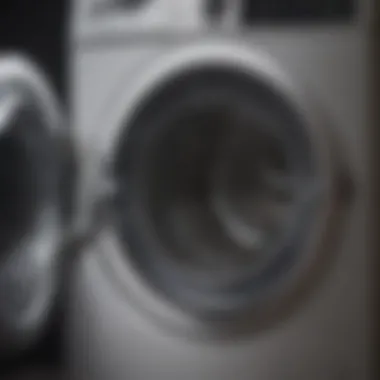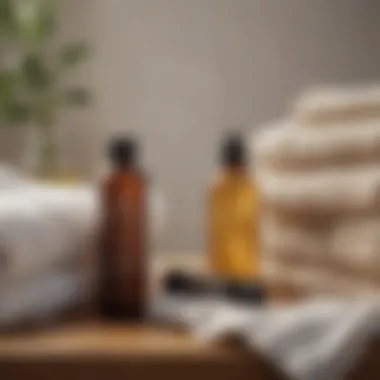Practical Ways to Eliminate Mildew Odors from Laundry


Intro
Mildew odors in laundry can be a nagging issue for many households, especially when humidity levels rise or clothes remain damp for too long. Such smells not only detract from the freshness of your laundry but may also linger on fabrics, posing a challenge for even the most diligent housekeeper. In this guide, we will explore effective strategies for banishing those unwanted odors, focusing on practical solutions that you can utilize without breaking the bank. Understanding the root causes of these smells is just as crucial as knowing how to eliminate them, and we will delve into both aspects.
From common household items to specialized treatments, we'll provide nuanced insights into techniques that restore your laundry's freshness. Moreover, we’ll highlight prevention strategies that ensure your clothes remain smelling pleasant over time. Whether you’re a busy housewife dealing with the consequences of damp season or a house owner looking for efficient maintenance tips, this article aims to equip you with the know-how to tackle mildew odors effectively.
By the end, you’ll be well-versed in the chemistry behind mildew formation and the various remedies you can implement. Let’s get down to the nitty-gritty of how to keep your laundry smelling as lively as it should.
Understanding Mildew Smells in Laundry
Mildew smells in laundry can be an unwelcome surprise, often turning what should be a pleasant chore into a frustrating experience. Having fresh-smelling clothes is not just a matter of preference; it is essential for comfort and maintaining a healthy living environment. Understanding the cause and nature of these odors is the first step towards effectively tackling them. This section peels back the layers on mildew odors, shedding light on their origins and how they manifest in our laundry.
What Causes Mildew Odors?
Mildew odors typically come from a certain type of fungus, which thrives in damp, warm environments. When moisture attaches to fabric and isn't properly dried, it creates the perfect breeding ground for mildew. Factors that contribute to these unwanted smells include:
- Excessive humidity: High humidity levels in laundry spaces can promote fungal growth. This is particularly common in basements or poorly ventilated areas.
- Wet clothes left in the washer: Leaving clothes damp in the washing machine for an extended period can lead to mildew development. Even a few hours can be too long, as the warmth and moisture create an ideal setting for mildew.
- Dirty or damp laundry: Clothes that have been soiled or are damp when put away will often emit a rotten odor due to the buildup of bacteria and mildew.
Monitoring and managing these elements can help in preventing mildew smells from taking root.
Identifying Mildew in Laundry
Recognizing mildew in laundry can sometimes be subtle. At first glance, your laundry might seem alright, but the telltale signs can be elusive. Here are a few key indicators to keep an eye out for:
- Distinct musty smell: This is usually the first thing people notice. If your clothes have that old, damp stench, it’s likely a sign of mildew.
- Visible spots or discoloration: Check carefully for any dark patches or discoloration on fabric surfaces, especially corners of towels and underarms of shirts.
- Dampness: If clothes feel unusually damp after a wash cycle, or they appear to take longer than normal to dry, it’s worth investigating further.
"Mildew loves to sneak in and make itself at home, but a little vigilance can keep it at bay."
Identifying these issues as early as possible can save you not only your garments but also the considerable effort required to eradicate these stubborn smells.
The Chemistry Behind Mildew Formation
Understanding the chemistry behind mildew formation is crucial in our quest to eliminate those unpleasant smells that can cling to our laundry. Mildew, often a consequence of fungal growth, can significantly affect the freshness of fabrics. To combat this problem, it's essential to grasp the elements at play within our washing machines and laundry rooms.
The relationship between moisture, warm temperatures, and organic materials creates an ideal environment for mold and mildew to flourish. When clothing becomes damp and is not dried promptly, it is left in a state that invites spores to settle in. Knowing how specific elements contribute to this can not only help in eradication but also in prevention strategies.
Fungal Growth and Its Impact
Fungal growth is at the heart of mildew formation. Fungi, including molds, thrive in humid and warm environments. Most common household fabrics, such as cotton or linen, can become breeding grounds for these unwanted guests if not properly cared for.
When mildew develops on items, it doesn't merely present a nuisance; it can potentially degrade the fabric itself. The enzymes secreted by molds break down cellulose—the main component in plant cell walls, found in cotton. Over time, this can lead to degraded fabrics, causing clothing to wear out prematurely.
To better combat mildew, it may help to understand the lifecycle of these fungi:
- Spore Germination: Mildew begins as tiny spores that are usually invisible. Under ideal conditions, these spores germinate quickly.
- Mycelium Growth: As spores germinate, they grow into mycelium, the root-like structure that spreads throughout the fabric.
- Mildew Production: Once established, the mold species can proliferate and create a musty smell.
Environmental Factors Contributing to Mildew
A variety of environmental factors influence the growth of mildew. Some critical elements include:
- Humidity Levels: Excess moisture in the air, particularly in poorly ventilated spaces, offers fungi a perfect atmosphere to proliferate.
- Temperature: Fungi thrive in warmth. The ideal temperatures for mildew are typically between 77 °F and 86 °F (25 °C to 30 °C).
- Poor Airflow: Enclosed laundry areas that do not permit airflow make for a cozy spot for mildew to settle in.


To minimize the chances of mildew growth in your laundry, consider the following actions:
- Use a dehumidifier in muggy weather.
- Store your laundry in a well-ventilated area.
- Avoid leaving wet clothes in the washing machine for extended periods.
In summary, understanding the chemistry behind mildew is imperative for effectively tackling this issue. The interplay of environmental factors, combined with the nature of fungal growth, highlights why prompt action is essential. This knowledge builds a foundation for the practical solutions we will explore for eradicating mildew odors in laundry.
Prevention Strategies for Mildew Smells
Mildew, that unwelcome guest, tends to make its presence felt, especially in laundry. To truly get ahead of the game, understanding prevention strategies is crucial. It’s not just about cleaning away the smell but establishing routines and habits that keep mildew at bay. The significance of adopting a proactive approach cannot be overstated: it saves time, money, and the frustration of dealing with stubborn odors later on.
Ideal Washing Practices
Starting with the basics—it's essential to employ washing practices that inhibit mildew growth. Here are some practical guidelines:
- Don’t Let Clothes Sit Wet: Once the wash cycle is done, take the clothes out of the machine. Leaving damp textiles inside is an open invitation for mildew. The longer they sit, the more they’ll smell.
- Choose the Right Detergent: Opt for high-quality detergents that include mildew-fighting agents. They penetrate fabric fibers better and help eliminate any lingering odors.
- Wash in Hot Water: If the fabric allows, washing in hotter water can kill mold spores. Just check care labels to avoid damaging delicate items.
"The best offense against mildew is a good defense with regular washing routines."
Regular washing not only maintains cleanliness but also prevents the buildup of moisture that feeds mold. Many people often overlook this simple act, thinking the detergent will do all the heavy lifting.
Proper Drying Techniques
Drying is just as important as washing. Below are techniques to ensure that your laundry dries effectively and maintains that fresh scent:
- Use a Dryer When Possible: While air drying is eco-friendly, the dryer is less favorable for mildew. High temperatures effectively evaporate moisture, making mildew formation less likely.
- Ensure Adequate Air Circulation: If using a drying rack, place it in a well-ventilated area. Position it far from walls or furniture, allowing air to circulate freely around the clothes.
- Keep the Washing Machine Door Open: Does your washing machine have a front or top door? Keep it ajar between loads to allow the interior to air out. This reduces the chance of mold growth inside the machine.
Following these drying techniques transforms the laundry process. They prevent the dampness that allows mildew to flourish.
Storage Solutions to Prevent Odors
Finally, storing clean laundry in a way that keeps them fresh is paramount. After all the washing and drying, proper storage can mean the difference between a pleasant scent and a funk:
- Use Breathable Containers: Storing clothes in plastic bins may sound practical, but they can trap moisture. Choose cotton bags or fabric storage bins that allow air exchange.
- Consider Drying Sheets: Placing a dryer sheet or a small sachet of lavender among clothes can help to absorb any humidity and impart a lovely fragrance.
- Create Airflow: Store large items, like blankets or winter coats, where air can circulate. Avoid packing items too tightly into storage spaces.
Maintaining freshness in stored laundry is key to battling mildew odors. By implementing these storage solutions, you're not just protecting your clothes; you're investing in a more pleasant home environment.
Immediate Remedies for Mildew Odors
Mildew odors can sneak into laundry, turning fresh fabrics into a sour experience. Fast action is crucial when these smells arise; addressing the issue promptly not only revives your clothes but can also prevent further infiltration of these musty scents into your household. In this section, we'll discuss three effective immediate remedies that can usher in freshness to your laundry routine. These solutions are grounded in common household items that work wonders and are easy to implement, empowering you to tackle unpleasant smells head-on.
Using Vinegar as a Natural Deodorizer
Vinegar has a long-standing reputation as a natural deodorizer, and boy, does it deliver! The acetic acid in vinegar helps neutralize odors, breaking down the compounds causing the unwelcome mildewy smell. When added to the rinse cycle of your laundry, it not only fights odors but also softens fabric without the need for harsh chemicals.
To use vinegar effectively:
- Add one cup of white vinegar to your rinse cycle.
- For stubborn odors, pre-soak laundry in a solution of vinegar and water for about 30 minutes before washing.
- Lint and residue will be removed, leaving your clothes smelling fresh.
It's wise to keep in mind that while vinegar does a stellar job at eliminating unpleasant smells, its scent dissipates quickly, leaving behind a freshness that doesn’t linger in a way some might find overpowering.
Baking Soda as an Effective Odor Neutralizer
Baking soda is another household staple known for its deodorizing properties. It's a natural way to neutralize odors and has the ability to absorb moisture, making it an ally against mildew. This method is especially handy for fabrics that absorb moisture, such as towels.


Here’s how to implement baking soda effectively:
- Before washing, sprinkle half a cup of baking soda directly onto the wet laundry in the washing machine.
- For persistent odors, dissolve one cup of baking soda in water and pre-soak your clothes for a few hours.
By making baking soda a part of your laundry routine, you're taking a simple step towards keeping clothes odor-free. Plus, it softens fabrics while you’re at it.
Essential Oils and Their Benefits
Many people overlook the power of essential oils, thinking of them mainly for aromatherapy. However, these concentrated plant extracts are not just good at smelling divine; they have properties that can combat mildew odors effectively. Essential oils such as tea tree, lavender, and lemon possess antifungal and antibacterial qualities that work wonders in laundry.
To incorporate essential oils into your washing routine:
- Add 10-20 drops of your chosen essential oil to the washing machine during the rinse cycle.
- Mix a few drops with baking soda to create a powerful odor-fighting paste that can be applied to affected areas before washing.
Among these oils, tea tree oil is particularly adept at fighting mold, while lavender and lemon add a comforting fragrance that's certain to uplift your laundry experience. Remember, a little goes a long way!
"Home remedies can be surprisingly effective in the fight against mildew. With items like vinegar, baking soda, and essential oils, you have access to tools right in your pantry!"
Specialized Laundry Products
When it comes to keeping laundry fresh and free from mildew odors, utilizing specialized laundry products can make all the difference. These products are specifically designed to tackle stubborn odors and grime that regular detergents might miss. Their unique formulations help break down the biological components of mildew, ensuring a cleaner wash and a fresher smell.
Enzymatic Cleaners for Deeper Cleaning
Enzymatic cleaners are a standout option when dealing with mildew. They contain enzymes that target and break down organic materials, such as sweat and food deposits, which can often serve as a breeding ground for mildew. When you wash with these cleaners, they actively work to digest the stains and odors, leaving your clothes not just clean, but fresh and revitalized.
For instance, when selecting an enzymatic cleaner, look for those that specify they combat mildew or mold. Remember, it’s not a one-size-fits-all approach. You’ll want to read the labels carefully to ensure you're using a product tailored for your specific needs. Substituting your regular detergent once in a while with an enzymatic cleaner can yield impressive results, especially for items that frequently encounter dampness, like towels or workout gear.
Mildew-Specific Detergents
Mildew-specific detergents are formulated with the unique task of eliminating mildew odors at their source. They often include ingredients that not only clean but also inhibit the growth of mildew and mold. When you put these detergents to the test, you might notice they foam differently, which is by design. This enhanced foaming action signals the formulation working to penetrate fibers more thoroughly, combating odors effectively.
It’s important to follow the usage instructions closely; using too much product can leave residue, and that's counterproductive. For maximum efficiency, consider soaking particularly odorous items before washing. A preparation step like this can enhance the deodorizing process. Investing in a mildew-specific detergent can provide an additional layer of protection, particularly in humid climates where mildew is more prevalent.
Odor Removal Sprays for Fabrics
In addition to washing solutions, odor removal sprays for fabrics present a handy option for dealing with mildew odors, particularly on items that aren’t easily washed, such as upholstery or curtain fabrics. These sprays work by neutralizing odors at the molecular level rather than merely masking them. This is a key difference. They often contain baking soda or other compounds like activated charcoal, which can absorb moisture and unwanted odors.
When using such sprays, a light misting is usually sufficient. Simply spray from a distance and allow the fabric to air out. Always conduct a spot test on an inconspicuous area first to ensure no damage occurs.
"Specialized laundry products are more than just an option; they’re an essential part of the arsenal against mildew. Invest wisely for lasting freshness!"
In summary, for those fighting the persistent odor of mildew in laundry, incorporating specialized laundry products into your routine can not only be beneficial—it can be a game changer. By integrating enzymatic cleaners, mildew-specific detergents, and effective odor removal sprays, you can maintain a fresh and clean laundry that feels as good as it looks.
Long-Term Solutions for Mildew-Free Laundry
Mildew odors in laundry can be a persistent problem, often leading to frustration and embarrassment. However, focusing on long-term solutions allows homeowners and housewives to create a robust framework that prevents mildew from taking hold in the first place. These approaches not only save time and effort spent battling odors down the line but also cultivate an overall fresher environment for clothes.
Taking a proactive stance begins with establishing a regular laundry routine and understanding the importance of humidity management. Both elements work synergistically to ward off mildew, making them essential to maintain freshness in your garments.
Establishing a Regular Laundry Routine
Nothing will shoot mildew odors in the foot quite like a steadfast laundry routine. Developing a consistent schedule for washing your clothes keeps damp items from languishing in the hampers for too long, where mildew loves to thrive.


- Set Weekly Goals: Aim to do laundry at least once or twice a week. Assign specific days for different items such as whites, darks, and delicates.
- Check for Dampness: Before tossing clothes into the hamper, shake out any damp garments. This simple act may seem trivial but helps mitigate the conditions that cause mildew.
- Avoid Overstuffing: Resist the urge to cram that washing machine full to the brim. Overloading limits the effectiveness of detergent and the circulation of water, making it harder for clothes to clean thoroughly.
- Utilize Heat Drying: Once washed, dry clothes promptly using a dryer on a suitable setting. If line drying outdoors, ensure clothes dry completely and avoid leaving damp items in the laundry basket.
"Routine, mixed with a dash of diligence, can make all the difference in your laundry endeavor."
The Role of Humidity Management
Humidity plays a pivotal role in mildew formation. Maintaining optimal humidity levels around the home—ideally between 30% and 50%—is crucial for keeping mildew at bay. Here are several tips to control humidity:
- Use Dehumidifiers: These devices are particularly beneficial in damp areas like basements or laundry rooms. They absorb excess moisture, creating an environment unfavorable for mildew growth.
- Ventilate: Good airflow in your laundry space can assist significantly. Open windows or use exhaust fans to decrease trapped moisture and enhance air quality.
- Indoor Plants: While they may seem counterintuitive, certain plants like peace lilies or spider plants can absorb excess humidity from the air.
- Monitor Weather Conditions: On especially humid days, consider delaying laundry. If you know it’s going to be muggy outside, wait until conditions improve.
Adopting these long-term strategies can ultimately help prevent the onset of mildew smells, ensuring your laundry remains fresh and welcoming.
The Importance of Maintenance and Care
Maintaining cleanliness in your laundry routine not only contributes to fresh-smelling clothes but also plays a critical role in prolonging the lifespan of your washing machine and protecting your health. A well-cared-for appliance runs more efficiently and reduces the likelihood of mildew growth, which can cause unpleasant odors and potential health issues. When we overlook the care of our washing machines, it can lead to a host of problems down the line, from odor retention to expensive repairs.
Consider this: regular maintenance can save you from the headache of dealing with musty smells seeping into your fresh laundry. Just like you wouldn’t let dust accumulate in your home, you shouldn't let mold and mildew build up in your washing machine. By implementing a maintenance routine, you can ensure your appliance stays in top shape and your laundry remains a pleasure to handle.
Routine Cleaning of Washing Machines
To start, a important step is implementing a routine cleaning schedule for your washing machine. Depending on usage, a monthly clean can keep the machine running optimally. This process generally involves running an empty cycle with hot water combined with either white vinegar or specialized washing machine cleaners. The vinegar serves to dissolve any residue, while its natural acidity can effectively kill mold spores and any lingering odors.
Additionally, pay attention to the rubber door seals and detergent dispensers, as these often become areas for mildew to thrive. A simple wipe-down with a mixture of water and a little bleach or vinegar does wonders.
Here’s a quick checklist for routine cleaning:
- Run a hot water cycle with vinegar monthly.
- Wipe down door seals regularly.
- Clean the detergent dispenser with warm soapy water.
- Leave the door open after each wash to allow air circulation.
Identifying Signs of Mildew in Machines
Now that you’re on the path to keeping your washing machine clean, it’s essential to recognize the signs that mildew may be lurking. Early identification is key in eradicating mildew offenders to prevent further damage and odors.
Look for:
- A persistent musty or damp smell coming from the machine.
- Dark spots or patches, especially in hidden areas such as door seals or detergent dispensers.
- Excessive soap scum buildup, which can create a breeding ground for mold.
If any of these signs appear, it’s crucial to act fast by cleaning the affected areas and running an empty machine cycle to eliminate the remnants of mildew. Moreover, using a moisture meter can help determine any excessive dampness in storage areas around the washing machine, preventing future issues.
Being proactive is always better than dealing with a mildew crisis. Remember, a little maintenance goes a long way in keeping your laundry environment fresh and healthy.
The End: Crafting a Fresh Laundry Environment
Ensuring a fresh laundry environment is not just about eliminating odors that clings stubbornly to fabrics. It's about establishing an ecosystem where your clothes can thrive, free from the unwanted invasion of mildew. A clean and pleasant-smelling laundry room can greatly enhance your overall laundry experience, fostering a sense of well-being and comfort in your home.
Summary of Best Practices
In this journey to eradicate mildew odors, having a toolkit filled with best practices can make a world of difference. Consider the following strategies:
- Wash Regularly: Regular laundry cycles limit mildew growth. Waiting too long gives moisture a chance to settle, creating the perfect breeding ground for mold.
- Use Hot Water: Whenever the fabric permits, hot water is the enemy of mildew. Aim for higher temperatures to kill spores effectively.
- Keep the Washer Dry: After each load, leave the washing machine door open for a bit to allow it to dry. A damp machine only invites mildew.
- Air Dry When Possible: Sunshine and fresh air are nature's best deodorizers; try to air dry your laundry to keep them smelling fresh.
- Elevate Storage Areas: When storing laundry baskets or bags, make sure they aren’t in damp or poorly ventilated spots. Elevated storage helps maintain airflow.
Maintaining these practices not only refreshes laundry but also prevents future mildew problems, protecting your investment in clothes.
Encouraging Proactive Habits
Being proactive is half the battle when it comes to preventing mildew odors. Here are a few habits you might consider adopting:
- Regular Machine Maintenance: Just like your vehicle, your washing machine needs care too. A weekly wipe down of seals and baskets ensures residues are minimized.
- Set a Schedule: Create a laundry calendar that keeps you on track. This way you won't find yourself with heaps of clothes destined for mildew.
- Educate the Household: Ensure everyone in your home understands the importance of keeping laundry practices efficient. Simple reminders can have a big impact.
- Create a Dedicated Space: Designate a fresh, dry area for folding and storing clean clothes, minimizing the time they sit in baskets or hampers where odors could develop.
- Stay Updated on Products: Subscribe to newsletters from brands that specialize in laundry products. This keeps you informed about the latest solutions aimed at mildew prevention.
Embracing these habits will set a robust foundation for keeping mildew at bay. A fresh laundry environment not only safeguards your fabrics but also contributes to a healthier home. Ultimately, the goal is to enjoy the simple pleasure of fresh, clean laundry without the shadow of mildew lurking around.



